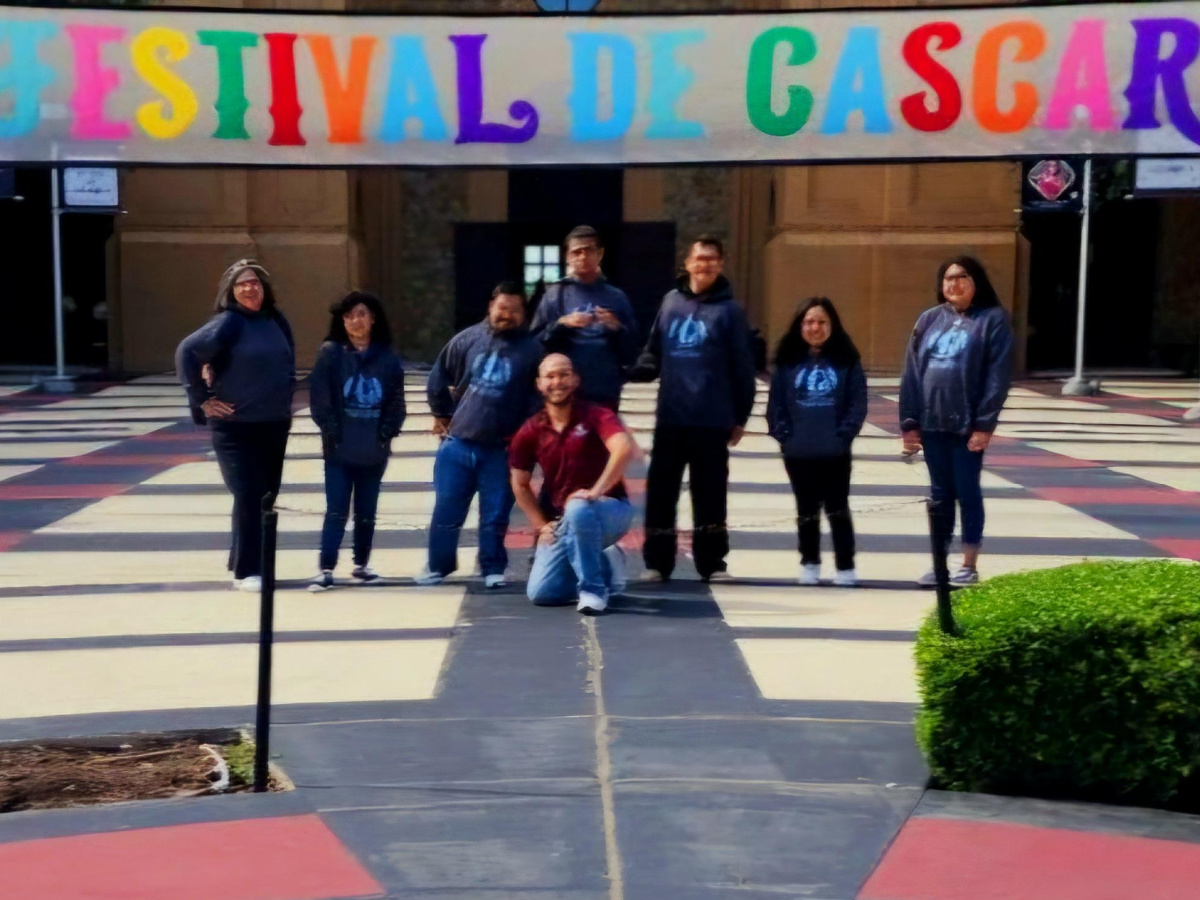Note from SA Charter Moms: We are proud to share guest posts from hallmonitor covering San Antonio’s public schools.

Brian Sparks eating lunch with kids at Lamar. (When I asked him for “a picture of you doing your job” this is what Brian sent. So fun!)
Promotions have long been one of the most unfortunate aspects of the education profession. If a talented teacher wants to advance beyond a modest income, they have to leave the classroom. That path leads through campus administration positions, the principal’s office, and eventually to Central Office where the salaries are significantly higher. It takes them away from the front lines of a battle they love.
So the best teachers and principals face a tough choice. Many leave campus, where they are desperately needed, in order to pay the bills as their own families grow.
In San Antonio ISD, that’s changing. It’s all hands on deck as Superintendent Pedro Martinez tries to turn the district around, and he needs those hands to be in their best-fit jobs.
When SAISD announced its Master Teacher initiative, funded by a tax rate increase and a $46 million federal grant, one of the key benefits was allowing teachers to continue directly influencing the classroom, while still advancing to higher salaries and professional stature. Now principals will get a similar chance, by becoming network principals.
Not only does the program keep good principals on campus, it also addresses the uneven nature of SAISD’s successes thus far. The district does have bright spots. It has MVP campuses and “most improved” campuses. But for all those on the rise, many are still on the decline. It has some of the best and worst performing schools in the city. The network principals will be charged with turning up the wattage on the bright spots so that more schools benefit.
Beginning next year, cohorts of successful principals will be asked to replicate their successes—though not necessarily using the same model—on a new campus while still overseeing their original school. The first cohort includes four of SAISD’s most celebrated principals, some who have accumulated official “gold stars,” and all with rockstar reputations within their campus communities.
Delia McLerran, who won Principal of the Year at H-E-B’s 2017 Excellence in Education awards, will open a second Young Women’s Leadership Academy. The location has not been decided, but the school will be part of the national Young Women’s Leadership network. The current YWLA campus in Monticello Park is the district’s most high-profile high school, earning National Blue Ribbon status in 2015, and a recurring spot on Top High School rankings in national publications.

Delia McLerran (in the rearview mirror) driving her students up to Austin on April 20 so they can advocate for stronger gun laws
Brian Sparks, the wildly popular principal of Lamar Elementary in Mahncke Park, will also lead Bowden Elementary, about a mile and a half away in Dignowity Hill. Sparks is beloved by many in the Lamar community for his highly responsive leadership, and he intends to take that approach at Bowden, where principal Anita O’Neill is retiring.
“I think it’s a chance to use lessons learned at Lamar and other places around the city,” Sparks said. Those lessons came from the process of forging numerous partnerships and an in-district charter status. With those in place, Lamar has a lot of freedom to tailor instruction to the needs to students and the resources available in the community, “I think a lot of the same principles apply (at Bowden).”
In Mahncke Park, as in Dignowity Hill, museums and nonprofits are close by. Lamar is also a lab school for Trinity University, a model that could be expanded if all partners were willing. Lamar and Bowden both serve extremely high poverty zip codes, with pockets of gentrification. As the neighborhood changes in Mahncke Park, Sparks has been able to bring those families into the school to increase diversity in Lamar’s classrooms. If he can harness that trend in Dignowity Hill, which is served by Bowden, the campus could similarly diversify, breaking up concentrated poverty, and benefitting all students.
But first, Sparks said, it will be time to listen to the community. He wants to get to know Bowden before assessing which initiatives and strategies will be the best fit. That engagement in and of itself, is a tough skill to master, and part of the secret to Sparks’s success.
He’s the kind of principal who could be on the path to Central Office, but that’s not where he wants to be. For now, his dream job is on campus. But he does want to grow. Now he can.
Sonya Mora, who led Gates Elementary out of longstanding “improvement required” status, doubling its test scores in 2016, will also lead Cameron Elementary, another East Side campus. Speaking before the school board in September of 2016, Mora commented on how the speed of improvement at Gates surprised even her. What she thought would be a multi-year trickle of change exploded in one year. At that meeting Gates’s trustee James Howard remarked on the campus’s climate and culture, which felt totally different than in years past, he said.
Alejandra Barraza, principal at Carroll Early Childhood Center, will also lead Tynan Early Childhood Center. Barraza was a panelist at the recent San Antonio Regional PK–12 Education Forum on early childhood education. Before the event, Barraza led a tour of Carroll, which had attendees singing her praises for the inspiring work being done. The inclusion of early childhood in the initiative is notable. With all the pressure on test scores, it’s not uncommon to see districts funnel talent toward 3rd–12th grade when students actually take state assessments. To invest in early childhood shows that the district is listening to research, not just reacting to test scores.
The cohort will spend the summer increasing their personal leadership capacity, ensuring that they are ready for the huge increase in responsibility. McLerran and Sparks are participating in a Texas Education Agency fellowship that provides training from Bellwether Education Partners, an education policy and organizational consulting group. All four principals will work closely with Mohammed Choudhury’s Office of Innovation, which will be spearheading the network principal initiative.
Resources will be critical to the initiative. Stretching one person thinner isn’t going to do much without some additional support. Existing schools that come under network principals could have access to school transformation grants and other financial helps. Campuses overseen by network principals will also have associate principals to make sure that the split time of the network principal doesn’t leave gaps in the day to day needs of the campus. Associate principals will oversee assistant principals and other campus administrative staff and have the chance to learn from the network principal.
Principals play a large role in another state-sponsored initiative, the System of Great Schools. As the district focuses more on accountability and authorizing and less on the day-to-day operations of each individual campus, the principals will play a critical role. Autonomous campuses mean empowered principals. Superintendent Pedro Martinez has repeatedly highlighted his efforts to get the right principals in the right places as the shift happens.
This approach is not without detractors. One of the key powers of the principals of the System of Great Schools will be hiring and firing. School redesigns have already eliminated protective contracts for teachers at Stewart Elementary, and when the district announced layoffs in the face of a budget crisis, many teachers came forward saying their principals had targeted them to be fired without justification. Principals are bosses, and not everyone loves their boss. When the boss gets more power, those strained relationships are going to be stressed.
The hope, of course, is that great principals will retain great teachers and the benefits go directly to kids. At the end of the day, that’s where the difference needs to be seen for this, or any, innovation to be considered a success. If SAISD does what it intends to do with the System of Great Schools, schools will have to produce results. Dispensing with ineffective models and bringing in new operators is key to the strategy, at least according to the Texas Education Agency. For the sake of students and their families it will be up to districts to do a good job regulating the process and clearly expressing expectations. If the district follows the spirit of the initiative, principals only get to keep their dream jobs if they are actually preparing students to win dream jobs of their own.
Originally published as “Like Master Teachers, SAISD’s new Network Principals can advance in the jobs they love,” Hall Monitor, June 15, 2018
Read more:
- “[Hall Monitor], SAISD Asked Business Leaders for Support and They Delivered,” San Antonio Charter Moms, September 9, 2018
- “[Hall Monitor] In Becoming a ‘System of Great Schools,’ SAISD Is Fighting for Its Life,” San Antonio Charter Moms, June 30, 2018
- “[Hall Monitor] Meet Relay Lab Schools, SAISD’s Third Partner Under SB 1882,” San Antonio Charter Moms, May 12, 2018










